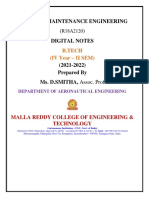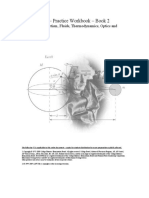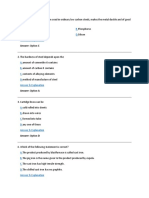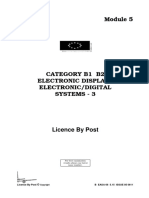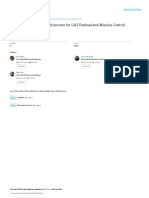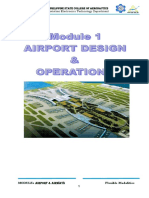Digital Number System
Digital Number System
Uploaded by
LeGrand BeltranCopyright:
Available Formats
Digital Number System
Digital Number System
Uploaded by
LeGrand BeltranCopyright
Available Formats
Share this document
Did you find this document useful?
Is this content inappropriate?
Copyright:
Available Formats
Digital Number System
Digital Number System
Uploaded by
LeGrand BeltranCopyright:
Available Formats
Philippine State College of Aeronautics
Associate in Aviation Electronics Technology
MODULE 2 Digital Techniques Flexible Modalities
1
Philippine State College of Aeronautics
Associate in Aviation Electronics Technology
LEARNING OUTCOMES:
• 3: Demonstrate a practical ability to accurately identify, carefully formulate, digital number systems,
effectively solve complex logic gate circuit problems by properly applying basic principles and
Course standard method to digital electronics in aircraft.
Learning • 10: Comprehend and explain the proper procedures to resolve digital electronic circuits.
Outcomes
• 1: Demonstrate the common characteristics of all the digital number systems.
• 2: Solve problem involving how a number with one radix is converted into a number with another
radix.
Module
Learning • 3: Demonstrate and properly explore the practical applications of digital number system in aircraft
Outcomes applications.
• 2: Discus and explain the fundamental working principles and application of the parts and
components of digital electronics.
• 3: Discuss and explain the different types of number systems as they relate to digital electronics.
Topic
Learning • 4: Discuss what methods and specific techniques to use to convert numbers into each other are
Outcomes applicable.
Weeks Topics/Activity Allotted Hours
Decimal Number System
Binary Number System 1.7 Hrs
Octal Number System
2 Activity No. 1 30 mins
Hexadecimal Number System
Digital Number Conversion 1.7 Hrs
Activity No. 2 30 mins.
MODULE 2 Digital Techniques Flexible Modalities
2
Philippine State College of Aeronautics
Associate in Aviation Electronics Technology
CONTENTS
Introduction..........................................................................................................................................4
1.0 Definition of Base Radix................................................................................................................5
1.1 Decimal Number System...............................................................................................................5
1.1.1 Disadvantages of the decimal system....................................................................................5
1.2 Binary Number System..................................................................................................................6
1.2.1 Conversion of a binary to its decimal equivalent ...................................................................6
1.2.2 Example how to convert decimal to binary.............................................................................7
1.3 Octal Number System....................................................................................................................8
1.3.1 Major Conversion octal to its decimal equivalent...................................................................8
1.3.2 Conversion procedures..........................................................................................................8
1.3.3 Conversion decimal to its octal equivalent.............................................................................9
1.3.4 Conversion of octal to binary equivalent ...............................................................................9
1.3.5 Conversion of binary to octal equivalent ...............................................................................9
1.4 Hexadecimal Number System.....................................................................................................10
1.4.1 Conversion of Hexadecimal to its decimal equivalent .........................................................11
1.4 2 Multiplication technique conversion......................................................................................11
1.4.3 Conversion of decimal to its Hexadecimal equivalent .........................................................11
1.4.4 Conversion of Hexadecimal to its binary equivalent............................................................12
1.4.5 Conversion of binary to its hexadecimal equivalent ............................................................12
1.5 Binary Code Decimal (BCD) ......................................................................................................13
1.6 Gray Code and 2 out of 5 Codes................................................................................................13
1.7 ASCII Code.................................................................................................................................14
1.8 Summary ....................................................................................................................................15
1.9 Key Points ..................................................................................................................................15
Activity ..............................................................................................................................................15
Honesty Clause.................................................................................................................................16
Rubrics..............................................................................................................................................17
References........................................................................................................................................18
MODULE 2 Digital Techniques Flexible Modalities
3
Philippine State College of Aeronautics
Associate in Aviation Electronics Technology
INTRODUCTION
In our daily lives we all use numbers to communicate and perform various tasks. The
measurements and numbers associated with everything characterize our present day world.
Number systems provide the means to convey and quantify information. One of the important
topics in digital electronics is the study of number systems in order to understand how information is
represented. Many of digital electronics applications, such as computers, do not process the
information as either alphabets or decimal numbers, but are designed using binary digit processing
circuits-only 0 and 1
Emphasis is given in this module on various number systems commonly used in the representation
of data. The debate starts with the basic decimal number system and its relationship to the binary
number system. The octal and hexadecimal numbers are described, with special reference to their
binary number system correlation.
TOPIC LEARNING OUTCOMES:
Upon completion of this Topic, you should be able to:
1. Discuss how numbers of different radices are formatted?
2. Explain how to convert a number with one radix into a number with a different radix.
3. Convert a given number in another system from one system to an equivalent number.
In aviation the world switching circuits of one kind or another are found in almost every piece of
electronic equipment ranging from ground radar systems, aircraft navigation and flight systems and
communications equipment. The switching systems, in the form of gate logic circuits and digital
computer units, may be relatively simple or quite complex, incorporating many interrelated circuits. It
is necessary to understand the numbering system on which this circuit operates and to be able to
interpret indications that may display those symbols (digit and letters) of the numbering system.
First of all, we will look at the different numbering systems which are used:
Decimal
Binary
Octal
Hexadecimal
For their structure and conversion to other systems, each numbering system will be examined.
Source: Digital Technique Electronics Instrument System
MODULE 2 Digital Techniques Flexible Modalities
4
Philippine State College of Aeronautics
Associate in Aviation Electronics Technology
1.0 DEFINITION OF BASE RADIX
The number of symbols used in a numbering system is determined by the base or radix of the
system, e.g. 10 digits (0,1, 2, 3, 4, 5, 6, 7, 8, 9) are used in the decimal system and it’s called a
base (or radix) 10 system.
A binary system only uses two symbols (0, 1) and it’s therefore called a base 2 systems.
When dealing with computer system it is often convenient to work with octal which is a base of
8 system using the (0,1, 2, 3, 4, 5, 6, 7) or hexadecimal which is a base of 16 system using of
a (0,1, 2, 3, 4, 5, 6, 7, 8, 9 and letters A, B, C, D, E and F).
Unless the base of the system being used is clear, a subscript of the bas should be used, e.g.:
Decimal - 14310
Binary - 10102
Octal - 3418
Hexadecimal - FA16
1.1 DECIMAL NUMBER SYSTEM
In this system the base is 10 consider the number 14310.
This is stated as One hundred and Forty Three.
Written in its full form it becomes: (1 x 10²) + (4 x 10¹) + (3 x 10º)
The 10², 10¹ and 10º is understood but each of them is prefixed by the appropriate coefficient
in this case 2, 8 and 3. It can therefore be seen that each power of 10 can have a coefficient
ranging from 0 to 9, again ten digits.
1.1.1 Disadvantage of the Decimal Number System
Calculations are performed in a digital computer in Central Processing Unit ( CPU), which may
consist of many transistor, diode ect. If a single transistor is used to count on base 10 decimal
scale, then 10 discrete collector current levels would be required, e.g. 0mA could represent an
input of 0, 1mA at input 1, 2mA at input 2 etc.
It would be extremely difficult to operate such a system and would require very careful design
with stabilized power supplies, negative feedback network, components of close tolerance, etc.
One requirement of a digital computer is that it is accurate and, therefore, even if they are
close to each other, it must be able to distinguish between numbers. Furthermore it is
important that the number does not drift with changes in the voltage or temperature of the
MODULE 2 Digital Techniques Flexible Modalities
5
Philippine State College of Aeronautics
Associate in Aviation Electronics Technology
power supply. It would be risky to expect a transistorized circuit to unerringly distinguish
between 10 different current magnitudes required by a decimal system.
There are only possible states in an electronic device where accuracy and speed are important
on which adequate reliance can be placed. These are the state and the state outside. These
states are the basis of the system that is used almost universally throughout digital processing
today and is called the system of binary base 2. By using two widely spaced current values
corresponding to the saturation (on) and cut-off (off) transistor outputs, the possibility of an
error representing a given number is minimized.
The on / off state of the transistor circuit reflects the binary numbers 0 and 1 and, since they
are well defined and can be easily distinguished from each other, they will not be affected by
even relatively large drifts in power supply voltage or operating temperature.
1.2 BINARY NUMBER SYSTEM
A decimal number, when written down does not have the base numbers 10º, 10¹, 10² etc,
included but are understood to be there. Furthermore the coefficient of each power of ten
ranged from 0 to 9.
In a binary number the base numbers 9power of 2) 2º, 2¹, 2² ect, are not shown, similar as
with decimal numbers and the coefficient of each base number can only be 0 or 1.
To explain this binary number 101010 is given in the top row below, underneath of each binary
digit is written its base number (power of 2) and in the last row appears the decimal weight of
each column.
1 0 1 0 - Binary Number
2³ 2² 2¹ 2º - Base Number 1010102 = 1010
8 4 2 1 - Decimal Weight
1.2.1 Conversion of a Binary Number to its Decimal Equivalent
To convert the above Binary number 1010 to decimal form, the decimal weight of each of the
base number having a coefficient of 1 (Binary digit=1) is added together giving:
8 + 0 + 2 + 0 = 10
Note: that any number with the exponent of 0 equals to 1 is true for any number having an index of
0 and any number with exponent of 1 is equal to that number.
MODULE 2 Digital Techniques Flexible Modalities
6
Philippine State College of Aeronautics
Associate in Aviation Electronics Technology
This is one way in which it is possible to convert any binary number into its equivalent decimal
number. For small binary numbers, this scheme is acceptable, i.e. numbers with a small
number of 0's and 1's, but becomes tedious when dealing with large binary numbers.
It is better to use the following successive multiplication technique to convert a binary number
to a decimal under these circumstances.
Because the binary number system is the only one recognized by a digital computer, it is
important to convert decimal numbers into their binary form.
Successive division by 2 is used to convert from decimal to binary, and the remainder of any
division (which must be either 0 or 1) is then successively recorded in a separation column.
The split by 2 continues until the number being split yields a response of 0 with a remainder of
1.
The binary number equivalent of the original decimal number is then taken from the bottom up
as the sequence or reminder reading. Since the last split, obviously.
1.2.2 The following is an example of how this conversion is carried out:
Convert ion of 21010 to Binary Number
217 ÷ 2 = 108 r. 1 - LBS
108 ÷ 2 = 54 r. 0
54 ÷ 2 = 27 r. 0
27 ÷ 2 = 13 r. 1
13 ÷2=6 r. 1 Read up to obtain binary equivalent
6 ÷2=3 r. 0
3 ÷2=1 r. 1
1 ÷2=0 r. 1 - MSB
21710 = 110110012
Source: Digital Technique Electronics Instrument System
MODULE 2 Digital Techniques Flexible Modalities
7
Philippine State College of Aeronautics
Associate in Aviation Electronics Technology
1.3 OCTAL NUMBER SYSTEM
The octal system, as the name implies, is base 8 systems with symbols 0 , 1 , 2, 3, 4, 5, 6 and
7. Powers of eight, such as (8 º, 8¹, 8² ect,) and the coefficient of each base number in the
range0 to 7 are now the weight factors.
To explain this, the octal number 236 is shown at the top below, its base number (power of 8)
is written below each octal digit, and the decimal weight of each column appears in the last
row.
2 3 6 - Octal number
8² 8¹ 8º - Base Number 2468 = 15810
64 8 1 - Decimal weight
1.3.1 Conversion of an Octal Number to its Decimal Equivalent
The decimal weight of each of the base numbers having a coefficient of 1 to 7 must be
multiplied by the respective octal digit of the octal number in order to convert the above-
mentioned octal number 236 to the decimal form, adding:
(64 x 2) + (8 x 3) + (1 x 6) = 15810
NOTE: Remember any number that has the exponent of 0 is equals to 1 and any number that has
the exponent of 1 is equals to that number.
Another method to convert its decimal equivalent to an octal number is the technique of
successive multiplication.
1.3.2 This conversion takes place as follows:
Multiply the most significant digit (the left-most digit) by 8 (base or radix).
Add the following octal digit of the octal number to this first product then multiply by 8 again.
To this product add the next digit multiply by 8 again. This process continues until the least
significant digit is added to the generated products; the conversion is completed at this point.
Source: Digital Technique Electronics Instrument System
MODULE 2 Digital Techniques Flexible Modalities
8
Philippine State College of Aeronautics
Associate in Aviation Electronics Technology
1.3.3 Conversion of a Decimal Number to its Octal Equivalent
To convert decimal to octal, successively divide the decimal number by 8, and record the
remainders.
Example:
Convert the decimal number 796 to its octal equivalent:
796 ÷ 8 = 99 r. 4 - LSD
99 ÷ 8 = 12 r. 3
12 ÷ 8 = 14 r. 4 Read up to obtain octal equivalent
1 ÷8=0 r. 1 - MSD
79610 = 14348
1.3.4 Conversion of an Octal to its Binary Equivalent
This octal number 1434 will now be converted to its binary equivalent which is accomplished
by taking each octal digit and converting it to a three-bit group as follows:
1 4 3 4 – Octal Number
001 100 011 100 – 3-bit group 14348 = 0011000111002 = 1100011002
Taking these results altogether gives: 79610 = 14348 = 11000111002
1.3.5 Conversion of a Binary number to its Octal Equivalent
To convert a binary number to its octal equivalent, the digits of the binary number are split into
three-bit groups, starting with the least significant bit (LSB= Right most bit). Zero are then
added before the most significant bit (MSB= leftmost bit) if necessary to complete the group of
Example:
Convert the binary number 10110011 to its octal equivalent.
Starting from the LSB and putting the digits in groups 3 gives
010/110/011
Source: Digital Technique Electronics Instrument System
MODULE 2 Digital Techniques Flexible Modalities
9
Philippine State College of Aeronautics
Associate in Aviation Electronics Technology
A zero must be placed in front of the MSB to complete the group of 3 before converting each
group to its value, i.e.
010 110 011 – 3-bit groups 101100112 = 2638
2 6 3 – octal number
Therefore: 101100112 = 2638
The successive multiplication technique in converting an octal number to its decimal equivalent
is shown below with the well-known octal number 236.
Octal -2 3 6
Conversion sums from multiplying by 8 and - 16 19 158
Adding next octal digit.
1.4 HEXADECIMAL NUMBER SYSTEM
This system is used mainly on those systems that handle large binary numbers and is used as
a shorthand method of writing binary numbers, as with the octal system. A base of 16 is used
for this system.
Since only ten different digit symbols (0 to 9) exist, however, six additional symbols must be
used for the full range of coefficients of each power of 16. These are the alphabet letters
which include A to F. The full set of the hexadecimal symbols is now available for each base
number (16º, 16¹, 16² ect).
0–9 A B C D E F –Hexadecimal symbols
0 – 9 10 11 12 13 14 15 – Decimal Weight
The hexadecimal number 1A3 is shown at the top, its base number (power of 16) is written
below each hexadecimal symbol and the decimal weight of each column appears in the last
row.
1 A 3 -Hexadecimal Number
16² 16¹ 16º -Base Number 1A316 = 41910
256 16 1 -Decimal Weight
Source: Digital Technique Electronics Instrument System
MODULE 2 Digital Techniques Flexible Modalities
10
Philippine State College of Aeronautics
Associate in Aviation Electronics Technology
1.4.1 Conversion of a Hexadecimal Number to its Decimal Equivalent
(256 x 1) + (16 x 10) + (1 x 3) = 419
The above computation illustrates how to convert decimal to hexadecimal number 1A3. The
decimal weight must be multiplied by the respective hexadecimal symbol of the hexadecimal
number of each of the base numbers with a coefficient of 1 to 9 or A to F and added together.
.
1.4.2 The successive multiplication technique is another technique to convert a
hexadecimal number to its decimal equivalent.
Multiply the most significant symbol (the left-most symbol) by 16.
Add the following hexadecimal symbol of the hexadecimal number to this first product then
multiply by 16 again.
Add the next symbol to this product then multiply by 16 again. This procedure continues until
the least significant symbol of the hexadecimal number is added to the products generated, at
this point the conversion is completed.
The successive multiplication technique in converting a hexadecimal number to its decimal
equivalent is shown below with the well-known hexadecimal number 1A3.
Hexadecimal 1 A 3
Conversion sums from multiplying by 16 and 16 + 26 + 419 1A316 = 41910
We recognize that the same method can be used to convert hexadecimal to decimal as within
the octal system, and we will see that the conversion between hexadecimal and binary is
carried out in a similar way to the octal system, also vice versa from decimal to hexadecimal.
1.4.3 Conversion of a Decimal Number t its Hexadecimal Equivalent
The decimal number has to be divided successively by 16 and the remainder are again read
upwards to give the hexadecimal number.
Example:
762 ÷ 16 = 47 r. 10 = A
47 ÷ 16 = 2 r. 15 = F Read up to obtain Hexadecimal equivalent
9 ÷ 16 = 0 r. 2
76210 = 2FA16
Source: Digital Technique Electronics Instrument System
MODULE 2 Digital Techniques Flexible Modalities
11
Philippine State College of Aeronautics
Associate in Aviation Electronics Technology
1.4.4 Conversion of a Hexadecimal Number to its Binary Equivalent
This conversion is done in the same manner as for octal to binary except that now each
hexadecimal symbol is given its binary equivalent as a group of 4.
So the hexadecimal number just found becomes:
2 F A - Hexadecimal Number 72610 = 2FA16 = 10111110102
0010 1111 1010 - 4 bit groups
Note: F and A are 15 and 10 respectively.
The complete conversion therefore is:
76210 = 2FA16 = 10111110102
1.4.5 Conversion of a Binary Number to its Hexadecimal Equivalent
To do this conversion, the same procedure as for octal is performed but the binary digit is
grouped into fours starting from LSB and adding zero as required to complete the group of 4 in
front of MSB.
Example:
Convert the binary 11011100101 to its hexadecimal equivalent number.
Group the digits in fours starting from the LSB nought has to be added in front of the MSB to
complete the grouping, thus: 0110/1110/0101.
Now put the appropriate symbol (digit or letter) for each group. This gives as the answer:
0110 1110 0101 - 4 bit groups
6 E 5 - Hexadecimal Number 110111001012 = 6E516
Source: Digital Technique Electronics Instrument System
MODULE 2 Digital Techniques Flexible Modalities
12
Philippine State College of Aeronautics
Associate in Aviation Electronics Technology
1.5 BINARY CODED DECIMAL (BCD)
The most appropriate form for internal computations is a binary coded system representation,
since there is a direct mathematical relationship for every bit in the number. Other codes are
more useful for interfacing with a user who typically wants to see I /O (input/output) in terms of
decimal numbers. The BCD system is the simplest and most widely used form of digital
system used for inputs and outputs.
Each decimal digit within the BCD system is expressed as a corresponding 4-bit binary
number. In other words, the 0-9 decimal digits are encoded as a 0000-1001 bit string. A space
is left between each 4-bit group to make that number easier to read. For instance, as shown
below, the decimal number 163 is equivalent to the BCD number 0000 0110 0011.
BCD 0 0 0 1 0 1 1 0 0 0 1 1
2³ 2² 2¹ 2º 2³ 2² 2¹ 2º 2³ 2² 2¹ 2º
Decimal 1 6 3
A generis code could use any n-bit to represent a piece of information BCD uses 4 bits
because that is the minimum needed to represent a 9. All bits are always written, even a
decimal 0 is written as 0000 in BCD.
Starting with decimal 10, the significant difference between BCD and the previous number
systems is that BCD loses the standard mathematical relationship of a weighted sum. BCD
uses 0001 0000 to 0001 0101, rather than using the 4-bit code string 1010 to 1111 for decimal
10 to 15.
The easiest way to convert between decimal and binary code is through BCD. Thus it is the
ideal form I /O interfacing. Since it maintains the mathematical relation between bits, the binary
number system is the ideal form for internal computations of the computer.
1.6 GRAY CODE AND 2 OUT OF 5 CODES
In analog to digital converters, gray code is often used, which develops this code by converting
an analogically changing value of parameters to digitized binary pulses (e.g. a sensing
element tuning predefined degrees of rotation to an encoding disc). The difference compared
to the natural binary or BCD code is that when the analogically changing parameter has
increased or decreased beyond a predefined measurement, only one bit changes the state
(going from 1 to 0 or vice-versa). This coding has the advantages of easy error detection. This
coding has the advantages of easy error detection. If two bits change after a step above or
below the predefined value of a parameter, something is wrong with the data.
Source: Digital Technique Electronics Instrument System
MODULE 2 Digital Techniques Flexible Modalities
13
Philippine State College of Aeronautics
Associate in Aviation Electronics Technology
The two out of 5 codes used on frequency selection devices offer similar advantages. Here,
two of the 5 bits (wire) are always 1 (open or grounded, depending on the logic assigned) and
there is 0 and the selected digit increment or decrement results in a bit change from 1 to 0 and
a bit change from 0 to 1.
Decimal Binary Gray 2 out of 5
0 0000 0000 10010
1 0001 0001 00011
2 0010 0011 00101
3 0011 0010 00110
4 0100 0110 01010
5 0101 0111 01100
6 0110 0101 10100
7 0111 0100 11000
8 1000 1100 01001
9 1001 1101 10001
1.7 ASCII CODE
We need more than just numerical representations to get data into and out of a computer; we
also have to take care of all the letters and symbols used in day-to-day processing. Input and
output information such as name, address, and description of items must be in a readable
format. But remember a digital system can only deal with 1's and 0's.
Most industries have settled on a code called the American Standard Code for Information
Interchange (ASCII) input / output (I /O). The ASCII codes depict all alphanumeric data used in
the I /O computer using 7 bits 128 different code combinations will yield seven bits.
Each time a key on an ASCII keyboard is depressed, that key is converted to every ASCII
code and processed by the computer. Then all information is converted from ASCII into
Standard English before outputting the computer contents to a display terminal or printer.
Source: Digital Technique Electronics Instrument System
MODULE 2 Digital Techniques Flexible Modalities
14
Philippine State College of Aeronautics
Associate in Aviation Electronics Technology
1.8 Summary
The numeral system is used in digital electronics to represent the information. The number system
has different bases, with the decimal, binary, octal, and hexadecimal being the most common. The
number system base or radix is the total number of the digit that is used in the number system.
Suppose if the system number representing the digit from 0 to 9 then the system base is the 10.
1.9 Key Points
A digital system can only understand the positional number system where there are a few symbols
called digits, and depending on the position they occupy in the number, these symbols represent
different values.
A value can be determined for each digit in a number using:
The digit
The position of digit in the number
The number system base (where the base is defined as the total number of digits in the
number system available).
Activity No. 2 (30 minutes to answer this Activity)
1. Summarize the benefits of using various digital number systems in the aviation field.
2. Convert the number given below from one system of numbers to an equivalent.
After your class schedule your appropriate response to these activity woks through
the Google Classroom platform. (Deadline of Submission to be discuss)
MODULE 2 Digital Techniques Flexible Modalities
15
Philippine State College of Aeronautics
Associate in Aviation Electronics Technology
Honesty Clause
This honesty clause establishes a fundamental social contract within which the College community
agrees to live. This contract relies on the conviction that the personal and academic integrity of each
individual member strengthens and improves the quality of life for the entire community. It
recognizes the importance of honesty, trust, fairness, respect, and responsibility and wishes these
principles to be a defining part of Philippine State College of Aeronautics
The Institute of Engineering and Technology values and fosters an environment of academic and
personal integrity, supporting the ethical standards of the engineering profession, where we design
and build for the benefit and safety of society and our environment.
I agree that the submission of any academic work shall constitute a representation on my part both
that such work has been done, and its submission is being made, in compliance with honesty and
integrity. Furthermore, my responsibility includes taking action when I have witnessed or am aware
of another’s act of academic dishonesty.
_________________________
Students Name over Signature
MODULE 2 Digital Techniques Flexible Modalities
16
Philippine State College of Aeronautics
Associate in Aviation Electronics Technology
Rubrics serve as a basis for evaluating the activities provided.
Criteria Excellent Very Good Good Fair Poor
Content The content is The content is Content is not Content is an Incomplete content
Development comprehensive, precise comprehensive, comprehensive and incomplete the topic is not clearly pointed
and encouraging, precise and encouraging, even is not clearly out and not
clearly stated and well encouraging, clearly though the topic is not indicated and is not encouraging (1 out
supported by the stated and well well supported but encouraging (2 of the of 5 questions had
(50 pts) subject. The writing and supported by the addressed.) To have 5 questions been addressed
its purpose are very subject. The scripture the subject matter addressed) with)
clear (Exceptionally, all and its purpose are inconsistent with its
questions were clear. (4 of the 5 content and to clarify
addressed) questions were thoughts. (It
addressed in an addressed 3 out of 5
exceptional way) questions
(50-41 pts) (40-31 pts) (30-21 pts) (20-11 pts) (10-10 pts)
Organization & Paper structure and The paper structure The paper's Paper structure and Organization and
Structure organization are and organization is organization and organization is not structure are not
excellent easy to follow. very clear and easy to structure are clearly easy to follow. The suitable for the topic.
The transitions of follow. Paragraph easy to follow. transitions to Paragraph is
(20 pts) paragraphs are present transitions throughout Paragraph transitions paragraphs need confused and
and very logical and the paper are present throughout the paper improvement thought is lacking
maintain the thought and logical and are present and logical transition.
flow throughout the maintain the flow of and maintain the flow
paper. thought. of thought.
(20-17 pts) (16-13 pts) (12-9 pts) (08 -05 pts) (04 -01 pts)
Format and Paper follows the exact The paper follows Most of the guidelines Paper complies with Paper disorder
References designated guidelines most guidelines and go through paper. some guidelines. made of lacks of
and correctly includes includes incorrect Borderlines, size of Included are elements incorrect
complete references. spacing between text paper, inappropriate borderlines, paper formatting this
lines, using different ink used and 3 size, inappropriate include as such:
font sizes with 4 references are ink used and 2 borderlines, paper
(20 pts) references. included. references. size, improper ink
used, overlap text,
copied plagiarized or
prepared by another
person with 1
reference are
included.
(20-17 pts) (16-13 pts) (12-09 pts) (08 -05 pts) (04 -01 pts)
Grammar Grammar rules, usage Grammar rules, usage Grammar rules, usage Paper made few Language utilizes
Punctuation and are fully followed, is followed and is followed and mistakes in grammar misleading
Spelling spelling is correct. spelling is correct. The spelling is correct. and spelling, conversional tone,
Language is very clear language is very clear Language is clear and language lacks made of numerous
(10 pts) and precise; sentences and precise; the precise; sentences clarification or grammatical and
consistently display structure of phrases is display varied includes some spelling errors.
strong, varied structure. consistently strong structure consistently misleading The activity was
The activity was and varied. strong. conversional tone. submitted two
submitted on time. The activity was The activity was The activity was weeks late.
submitted two days submitted four days submitted one week
late. late. late.
(10-09 pts) (08-07 pts) (06-05 pts) (04-03 pts) (02-01 pts)
MODULE 2 Digital Techniques Flexible Modalities
17
Philippine State College of Aeronautics
Associate in Aviation Electronics Technology
REFERENCES
Digital Techniques Electronics Instruments Aviation Maintenance Technician Certificate
Series, retrieved from:
ttps://www.scribd.com/document/427718484/MODULE-5-Digital-Techniques-Electronic Instrument-
Systems
Electronic Flight Information Systems, retrieved from:
https://www.flight-mechanic.com/electronic-flight-information-systems/
Electronics Flight Instrument System, Retrieved from:
https://www.theairlinepilots.com/forumarchive/pilotslounge/efis.pdf
Electronics Flight Instrument System, Retrieved from:
https://www.theairlinepilots.com/forumarchive/pilotslounge/efis.pdf
(Mike Tooley 2013) Aircraft Digital Electronic and Computer Systems: Principle Operation and
Maintenance, retrieved from:
https://www.classicaviation.in/uploads/ebook/1539501241Mike_Tooley_Aircraft_Digital_Electronic_a
nd-_Computer_Systems.pdf
Part 66 Cat. B1 Module 5 Digital Techniques/Electronic Instrument System, Retrieved from:
https://www.ksu.lt/wp-content/uploads/2017/06/M5-Selected-pages.pdf
MODULE 2 Digital Techniques Flexible Modalities
18
You might also like
- Digital Systems From Logic Gates To ProcessorsDocument248 pagesDigital Systems From Logic Gates To ProcessorsAnonymous S6UCpG1ZuP92% (13)
- Aircraft Maintenance EngineeringDocument159 pagesAircraft Maintenance EngineeringBereket TarikuNo ratings yet
- Associate in Aviation Electronics Technology: Philippine State College of AeronauticsDocument20 pagesAssociate in Aviation Electronics Technology: Philippine State College of AeronauticsLeGrand BeltranNo ratings yet
- CCNA 3 Scaling NetworksDocument2 pagesCCNA 3 Scaling NetworksSam BateNo ratings yet
- B1/B2Document13 pagesB1/B2Zahid Mahmood100% (1)
- AERO 2012q1 Article2Document6 pagesAERO 2012q1 Article2Carlos AlvarezNo ratings yet
- AVT 2217 Module 2 - Runway MarkingsDocument21 pagesAVT 2217 Module 2 - Runway MarkingsLeGrand BeltranNo ratings yet
- Associate in Aviation Electronics Technology: Philippine State College of AeronauticsDocument20 pagesAssociate in Aviation Electronics Technology: Philippine State College of AeronauticsLeGrand BeltranNo ratings yet
- Digital Electronics and OpticsDocument90 pagesDigital Electronics and OpticsSteve MachariaNo ratings yet
- ICAT Syllbus For Part 66Document28 pagesICAT Syllbus For Part 66AzriSafwanRusliNo ratings yet
- Easa Part 66 Module 6Document4 pagesEasa Part 66 Module 6PRASADNo ratings yet
- Basic Aircraft Maintenance Training - Aviation Physics Training Course - EASA Part-66 - EASA PART-147 - FL Technics TrainingDocument4 pagesBasic Aircraft Maintenance Training - Aviation Physics Training Course - EASA Part-66 - EASA PART-147 - FL Technics TrainingPhil ZimbNo ratings yet
- Types of Computer Errors PDFDocument39 pagesTypes of Computer Errors PDFJoshua Guiriña0% (1)
- Emergency Locator TransmitterDocument2 pagesEmergency Locator Transmitterajaydce050% (1)
- UTPRAS - TR Based - Tools and Equipment & Facilities Requirements - Computer Systems Servicing NC IIDocument3 pagesUTPRAS - TR Based - Tools and Equipment & Facilities Requirements - Computer Systems Servicing NC IIMarkNo ratings yet
- CSS LongQuizDocument2 pagesCSS LongQuizCarren Joy LazoNo ratings yet
- Edited Unit 3 PPT - Cms >Document65 pagesEdited Unit 3 PPT - Cms >Moorthy Govindaraj100% (1)
- Workbook 2 Full PDFDocument398 pagesWorkbook 2 Full PDFpannNo ratings yet
- Table of Specification Css Grade 11Document1 pageTable of Specification Css Grade 11Barbie BeltranNo ratings yet
- Learning Area Grade Level Quarter Date I. Lesson Title Ii. Most Essential Learning Competencies (Melcs) Iii. Content/Core ContentDocument5 pagesLearning Area Grade Level Quarter Date I. Lesson Title Ii. Most Essential Learning Competencies (Melcs) Iii. Content/Core ContentYne AhuninNo ratings yet
- Louiglen - P CSS-3rd-Periodical-Exam-Test-PaperDocument3 pagesLouiglen - P CSS-3rd-Periodical-Exam-Test-PaperLouiglen PacanaNo ratings yet
- Data Communication Lesson Plan and SyllabusDocument10 pagesData Communication Lesson Plan and SyllabusanirudhshekhNo ratings yet
- Learning Material Unit 3,4Document34 pagesLearning Material Unit 3,4J.Gowri ShankarNo ratings yet
- A. B. C. D. Answer & ExplanationDocument16 pagesA. B. C. D. Answer & Explanationahmish kabbaxeNo ratings yet
- Module 1 Installing Computer Systems and Networks StudentDocument78 pagesModule 1 Installing Computer Systems and Networks StudentMiko SantosNo ratings yet
- Assemble and Dissassemble QuestionDocument5 pagesAssemble and Dissassemble Questionmichael rey floresNo ratings yet
- Quiz On Basic Flowcharting On ChsDocument11 pagesQuiz On Basic Flowcharting On ChsMacly UmaliNo ratings yet
- M4 Electronic Fundamentals Cat B1 V432Document68 pagesM4 Electronic Fundamentals Cat B1 V432Mohammed Saadah100% (1)
- Computer Motherboard I. Computer Motherboard: Property of STIDocument4 pagesComputer Motherboard I. Computer Motherboard: Property of STIRachelle GandaNo ratings yet
- 3 Coc Sample ExamDocument18 pages3 Coc Sample ExamAlem GirmaNo ratings yet
- 4.session Plan (1 Unit of Comeptency)Document9 pages4.session Plan (1 Unit of Comeptency)Frank Elmer AgbayaniNo ratings yet
- Computer System Servicing Grade 11 Module Q2 1Document124 pagesComputer System Servicing Grade 11 Module Q2 1Jellie Ann DayawonNo ratings yet
- 2002 - Future Architecture of Flight Control Systems - IEEEDocument7 pages2002 - Future Architecture of Flight Control Systems - IEEEMustafa AkınNo ratings yet
- EASA Mod 5 BK 5 FDR PDFDocument69 pagesEASA Mod 5 BK 5 FDR PDFNavaraj BaniyaNo ratings yet
- ExercisesDocument3 pagesExercisesMarshmallow Flavored CondomsNo ratings yet
- 25 Digital20 Avionics Pastor PDFDocument9 pages25 Digital20 Avionics Pastor PDF083898025012No ratings yet
- M6 Hardware (Phase B)Document88 pagesM6 Hardware (Phase B)Moin IqbalNo ratings yet
- BS Aeronautical Engineering (BSAE) - School of AviationDocument9 pagesBS Aeronautical Engineering (BSAE) - School of AviationUniversity of Perpetual Help System DALTANo ratings yet
- Maintenance Control CentreDocument1 pageMaintenance Control CentreNikiNo ratings yet
- Network CablingDocument4 pagesNetwork CablingRomeo T. Navarro Jr.No ratings yet
- TASK SHEET 1.3-3 Develop An Information SheetDocument26 pagesTASK SHEET 1.3-3 Develop An Information SheetAllan PachecoNo ratings yet
- CG AutomotiveDocument21 pagesCG AutomotiveHari Ng SablayNo ratings yet
- List of Tools, Equipment and Materials Computer System Servicing NC IiDocument2 pagesList of Tools, Equipment and Materials Computer System Servicing NC IiAllan Dave AlperezNo ratings yet
- 8-Evidence PlanDocument2 pages8-Evidence PlanFlorante De LeonNo ratings yet
- Task Sheet 1.3-2 - Premilinary Pages of CBLMDocument7 pagesTask Sheet 1.3-2 - Premilinary Pages of CBLMKindly LegarteNo ratings yet
- LONG - Major Hardware Components of A Computer SystemDocument1 pageLONG - Major Hardware Components of A Computer SystemVNo ratings yet
- Core 2 Edited DoneDocument55 pagesCore 2 Edited DonebpaulajoyceNo ratings yet
- TLE CHS q3 Mod5 Safety Precautions (Occupational Health and Safety)Document15 pagesTLE CHS q3 Mod5 Safety Precautions (Occupational Health and Safety)Alona AcotNo ratings yet
- Css Coc1 Lo1 Session PlanDocument5 pagesCss Coc1 Lo1 Session PlanLemuel Ramos RempilloNo ratings yet
- EMtech-CSS 2019Document12 pagesEMtech-CSS 2019danding aganonNo ratings yet
- Interactive Workbook - Maroof Tahir L1F20BSSE0419Document73 pagesInteractive Workbook - Maroof Tahir L1F20BSSE0419m gondalNo ratings yet
- Digital Techniques Electrical Instrument Systems: 5.4 Data BusDocument37 pagesDigital Techniques Electrical Instrument Systems: 5.4 Data BusAlexs SolemanNo ratings yet
- Rating SheetDocument7 pagesRating SheetxxxxNo ratings yet
- General Danger GoodsDocument8 pagesGeneral Danger GoodsAleNo ratings yet
- 9 - 28 - 0 - 0 - 40 - 5th Electrical DE&MPDocument165 pages9 - 28 - 0 - 0 - 40 - 5th Electrical DE&MPvijay kumar GuptaNo ratings yet
- 1st Year SyllabusDocument7 pages1st Year Syllabuschhotonroy98745No ratings yet
- 3.1 Operating Systems (Os) : (Common With Information Technology)Document16 pages3.1 Operating Systems (Os) : (Common With Information Technology)Gurbhej PannuNo ratings yet
- CS - ECE - EEE - INSTR F215 Digital Design Handout I Sem 2023-24Document4 pagesCS - ECE - EEE - INSTR F215 Digital Design Handout I Sem 2023-24f20220264No ratings yet
- Digital Circuits & Logic DesignsDocument23 pagesDigital Circuits & Logic DesignssamNo ratings yet
- Cte 121Document24 pagesCte 121estheroluwafemi86No ratings yet
- Computer Organization and Design Final After CorrectionsDocument238 pagesComputer Organization and Design Final After CorrectionsPritha ThangaveluNo ratings yet
- Philippine State College of Aeronautics Aviation Electronics Technology DepartmentDocument22 pagesPhilippine State College of Aeronautics Aviation Electronics Technology DepartmentLeGrand Beltran100% (1)
- AVT 2217 Module 5 - Airport Lighting SystemDocument17 pagesAVT 2217 Module 5 - Airport Lighting SystemLeGrand BeltranNo ratings yet
- AVT 2217 Module 1 - Airport Design and OperationDocument15 pagesAVT 2217 Module 1 - Airport Design and OperationLeGrand BeltranNo ratings yet
- Mckenzie, J. (2016)Document38 pagesMckenzie, J. (2016)LeGrand BeltranNo ratings yet
- Data Signal ConversionDocument18 pagesData Signal ConversionLeGrand BeltranNo ratings yet
- Thyristors: What You'll Learn in Module 6.0Document41 pagesThyristors: What You'll Learn in Module 6.0LeGrand BeltranNo ratings yet
- Aviation Spectrum Resources, Inc. Selective Calling (SELCAL) Users GuideDocument35 pagesAviation Spectrum Resources, Inc. Selective Calling (SELCAL) Users GuideLeGrand BeltranNo ratings yet
- Mitmw Research FinalDocument15 pagesMitmw Research FinalLeGrand BeltranNo ratings yet

